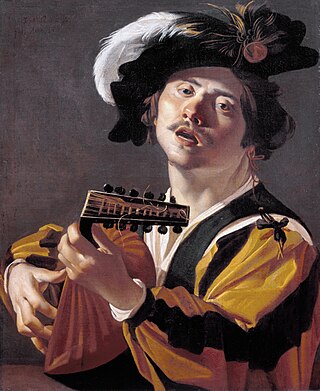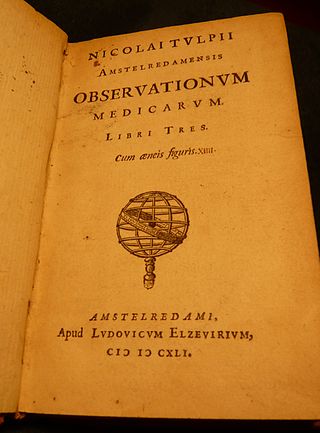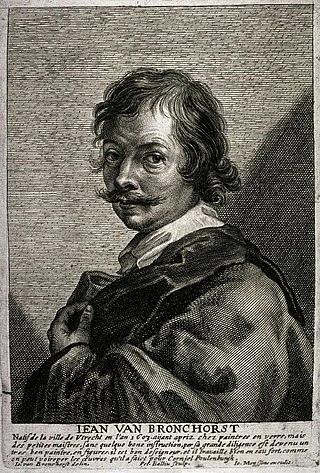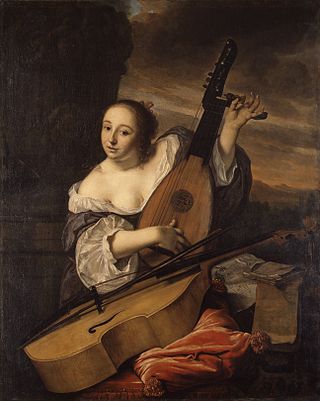
Dirck Jaspersz. van Baburen was a Dutch painter and one of the Utrecht Caravaggisti.

Lodewijk Elzevir, originally Lodewijk or Louis Elsevier or Elzevier, was a printer, born in the city of Leuven. He was the founder of the House of Elzevir, which printed works such as "Two New Sciences", written by Galileo, at a time when his work was suppressed for religious reasons. Although the House of Elzevir ceased publishing in 1712, the modern Dutch Elsevier company was founded in 1880 and took its name from the historic Dutch publishing house.

Gerard van Honthorst was a Dutch Golden Age painter who became known for his depiction of artificially lit scenes, eventually receiving the nickname Gherardo delle Notti. Early in his career he visited Rome, where he had great success painting in a style influenced by Caravaggio. Following his return to the Netherlands he became a leading portrait painter. Van Honthorst's contemporaries included Utrecht painters Hendrick Ter Brugghen and Dirck van Baburen.

Utrecht Caravaggism refers to the work of a group of artists who were from, or had studied in, the Dutch city of Utrecht, and during their stay in Rome during the early seventeenth century had become distinctly influenced by the art of Caravaggio. Upon their return to the Dutch Republic, they worked in a so-called Caravaggist style, which in turn influenced an earlier generation of local artists as well as artists in Flanders. The key figures in the movement were Hendrick ter Brugghen, Gerrit van Honthorst and Dirck van Baburen, who introduced Caravaggism into Utrecht painting around 1620. After 1630 the artists moved in other directions and the movement petered out. The Utrecht Caravaggisti painted predominantly history scenes and genre scenes executed in a realist style.

Hendrick Jansz ter Brugghen was a Dutch painter of genre scenes and religious subjects. He was one of the Dutch followers of Caravaggio – the so-called Utrecht Caravaggisti. Along with Gerrit van Hondhorst and Dirck van Baburen, Ter Brugghen was one of the most important Dutch painters to have been influenced by Caravaggio.

Adriaen van Utrecht was a Flemish painter known mainly for his sumptuous banquet still lifes, game and fruit still lifes, fruit garlands, market and kitchen scenes and depictions of live poultry in farmyards. His paintings, especially the hunting and game pieces, show the influence of Frans Snyders. The two artists are considered the main inventors of the genre of the pronkstillevens, i.e. still lifes that emphasized abundance by depicting a diversity of objects, fruits, flowers and dead game, often together with living people and animals. Van Utrecht also painted a number of flower still lifes. He was a regular collaborator with leading Antwerp painters who had been pupils or assistants of Peter Paul Rubens, such as Jacob Jordaens, David Teniers the Younger, Erasmus Quellinus II, Gerard Seghers, Theodoor Rombouts, Abraham van Diepenbeeck and Thomas Willeboirts Bosschaert.

Jan Gerritsz van Bronckhorst was a Dutch Golden Age painter and engraver. He is considered today to be a minor member of the Utrecht Caravaggisti.

The Centraal Museum is the main museum in Utrecht, Netherlands, founded in 1838. The museum has a wide-ranging collection, mainly of works produced locally. The collection of the paintings by the Northern Mannerist Joachim Wtewael is by a long way the largest anywhere in the world. Other highlights are many significant paintings by the Utrecht Caravaggisti, such as Gerard van Honthorst and Hendrick ter Brugghen. Both of them travelled to Rome in the early 17th century to study the works of the Italian master Caravaggio. In the previous generation, as well as Wtewael, Abraham Bloemaert and the portraitist Paulus Moreelse were the most significant Utrecht painters, with Jan van Scorel still earlier.

Johannes Hubertus Leonardus de Haas was a Dutch animal and landscape painter, and a peripheral figure of the Hague School.

Gilliam van der Gouwen, first name also transcribed as Guilliam and Willem was a Flemish engraver who spent most of his active career in the Dutch Republic. He is known for his reproductive engravings and various title pages, maps and book illustrations for the Amsterdam publishers.

The Serenade is a 1629 oil painting by Judith Leyster in the collection of the Rijksmuseum. It was attributed for centuries to Frans Hals until Wilhelm von Bode saw it in the Six collection in 1883. He noticed the prominent "J" in the signature, and attributed it to Jan Hals. This is one of seven paintings first properly attributed to Leyster by Hofstede de Groot ten years later in 1893.

The Musician (1662) is an oil on canvas painting by the Dutch painter Bartholomeus van der Helst. It is an example of Dutch Golden Age painting and is part of the collection of the Metropolitan Museum of Art.

The Baptism of Christ or the Jan des Trompes Triptych is an altarpiece painted between 1502 and 1508 by the Flemish painter Gerard David. It is now in the Groeningemuseum in Bruges, Belgium.

As of 2018, Wolters Kluwer ranks as the Dutch biggest publisher of books in terms of revenue. Other notable Dutch houses include Brill and Elsevier.

Interior of St Bavo's Church in Haarlem is a 1636 oil on panel painting by the Dutch artist Pieter Jansz Saenredam, now in the Rijksmuseum Amsterdam. As the title suggests, it shows a view of the interior of St Bavo's Church in the Dutch town of Haarlem.

Vanitas with the Spinario is a 1628 still life painting by Pieter Claesz, now in the Rijksmuseum in Amsterdam. It belongs to the sub-genre of vanitas. To the left is a reduced-size reproduction of the Spinario statue.

Merry Company is a 1622 oil on canvas painting by the Dutch artist Gerard van Honthorst. Set in a tavern, it is also known as The Prodigal Son, The Return or Celebratory Party. It is held in the Alte Pinakothek in Munich. The merry company, showing a group of drinkers, was a common subject-type in Dutch Golden Age painting.

Smiling Girl, a Courtesan, Holding an Obscene Image, also known in Dutch as Een Laggende Vrouw met een naakte Pourtraitje in de Hand, waar onder divisje staat or Jonge vrouw met een medaillon, is an oil painting on canvas by Gerard van Honthorst, created in 1625. It is held in the Saint Louis Art Museum where it is on view in Gallery 236.
Eduard Siegfried"Eddy"de Jongh is a Dutch art historian specialized in iconography. He was professor of art history with a teaching assignment in iconography at Utrecht University between 1976 and 1989.

The Preaching of the Antichrist is a fresco by the Italian Renaissance painter Luca Signorelli. It is one of the scenes of what is considered his masterpiece, the cycle of frescoes with apocalyptic themes that decorate the Chapel of San Brizio in Orvieto Cathedral (1499–1504). Michelangelo was inspired for his The Last Judgment by observing Signorelli's frescoes in Orvieto.



















